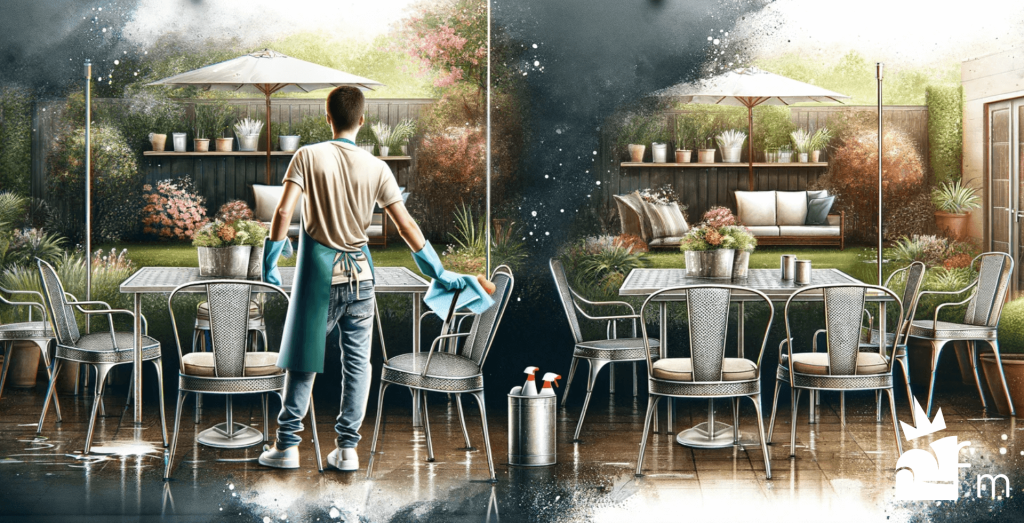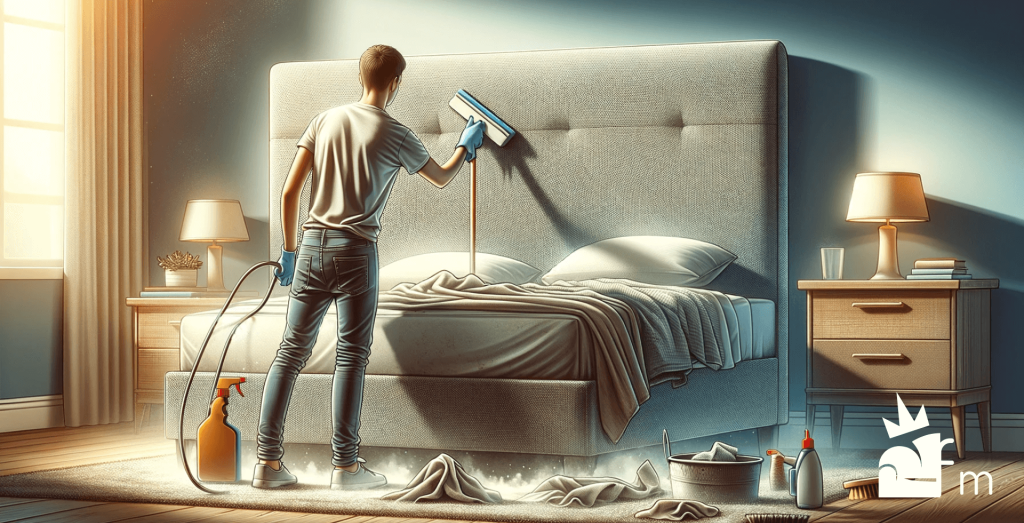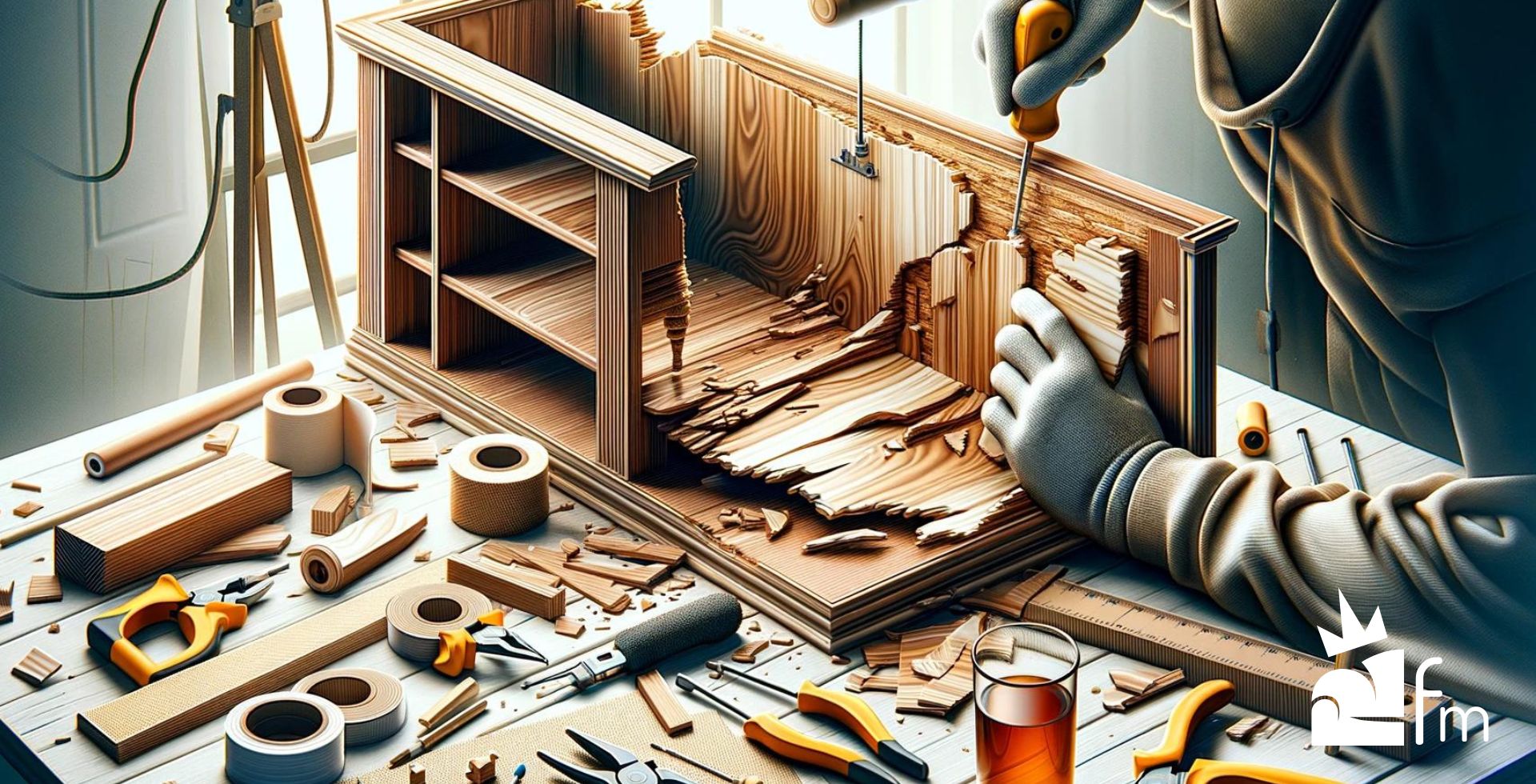You’ve just discovered a chipped corner or a water stain on your particle board furniture, and you’re contemplating whether it’s time for a new piece or if there’s a way to restore its former glory. Also, from kitchen to house flooring, you can see particle boards are used in many areas of your house. One of the main issues with particle boards you face is they often get ruined with water and might get swollen and loose surface smoothness.
But don’t worry; the good news is that repairing damaged particle board furniture is not only feasible, but it’s also a cost-effective alternative to outright replacement. With the right tools and techniques, you can breathe new life into your furniture, extending its lifespan and improving its appearance.
In this guide, we will walk you through the step-by-step process to tackle common issues like chipping, bubbling, and staining, turning that eyesore back into a functional and attractive piece of furniture.
Stay tuned to find out how!
- What Other Natural Events Can Ruin Particle Boards?
- Required Equipment and Tools
- 5 Tips to Fixed Swollen Particle Boards with Ease
- How to Take Care of Particle Board Furniture?
- FAQ
What Other Natural Events Can Ruin Particle Boards?
Particle board furniture may be budget-friendly and versatile, but it’s also susceptible to damage from various natural elements. While it may appear sturdy, certain environmental factors can compromise its integrity and lifespan.
Therefore, water is not the only source that can damage your chipboards; there are plenty of other things you need to worry about.
i. Humidity and moisture: The silent deterioration that swells and weaken boards over time
Moisture is the particle board’s worst enemy. Not only can the boards swell and deform, but they can also become a breeding ground for mold and mildew if left damp for too long. Even ambient moisture in the air, common in regions with high humidity, can slowly cause the board to lose its shape and structural integrity.
ii. Extreme temperatures: The faul threat that can warp and crack your furniture depending on Seasonal Changes
Particle boards are sensitive to temperature fluctuations. During hot summer months, the adhesive that holds the particles together can soften, making the board susceptible to warping. Conversely, cold winter temperatures can make the board contract, making it brittle and prone to cracks and fissures.
iii. Sunlight: The underestimated fader and structural weaker that degrades over time
Constant exposure to the sun’s ultraviolet rays can not only cause the colors of your particle board furniture to fade but can also degrade the very fibers and adhesives that compose the board. Over time, this can result in a significantly weaker piece of furniture that may fail under even minimal stress.
iv. Insects: The hidden invaders that compromise internal integrity through slow erosion
Certain insects, particularly wood-boring types like termites and carpenter ants, find particle board to be an attractive nesting ground. They can gradually hollow out the inside of the board, causing a loss of structural integrity that might not be immediately apparent from the outside.
v. Air pollutants: The stealthy degradation agents that affect surface quality
Floods, hurricanes, and earthquakes pose severe risks. Flood waters can inundate the particle board, making it unsalvageable due to severe swelling and potential mold growth. Hurricanes can cause physical damage like cracks and breaks due to flying debris or falls. Earthquakes can also subject your furniture to forces that can cause structural failures, from minor fractures to total collapse.
20 Equipment and Tools for the Cleaning

Make sure that all your equipment and tools are available while you start the process. The items you will need,
10 Essential Tools
- Screwdriver set: For disassembling and reassembling the furniture, if needed.
- Hammer: For any small nails or pegs that may require adjustment.
- Pliers: Useful for removing any damaged hardware.
- Utility knife: For trimming and cutting away damaged or loose parts.
- Sanding block or sandpaper: Various grits for smoothing out rough areas.
- Tape measure: For precise measurements when cutting new pieces or applying fillers.
- Putty knife: To apply and smooth wood filler or putty.
- Clamps: To hold pieces securely while gluing or setting.
- Chisel: For removing damaged areas with precision.
- Paintbrush or foam brush: For applying sealant, primer, or paint.
10 Must Have Materials
- Wood filler or putty: To fill in gaps or damaged areas.
- Particle board or veneer sheets: For replacing damaged sections.
- Wood glue: A strong adhesive specifically designed for wood materials.
- Nails and screws: For secure attachment and reassembly.
- Sealant: To seal edges and surfaces for moisture protection.
- Primer: For preparing the surface before painting or staining.
- Paint or stain: To match the existing finish or for a new look.
- Painter’s tape: For masking off areas you don’t want to paint or stain.
- Disposable gloves: For personal protection, especially when using chemicals or paints.
- Safety goggles: To protect your eyes from debris and chemicals.
5 Tips of How to Repair Damaged Particle Board Furniture
Tackling the issue of swollen particle boards in your furniture may seem complicated, but it doesn’t have to be. You can bring your furniture back to its original state with some straightforward techniques.
a. Use a hair dryer to gradually remove moisture
Utilizing a hair dryer for this purpose may seem unconventional, but it is a handy tool in the DIY repair kit. Position the hair dryer about 6-8 inches from the damaged area and use a low heat setting. The heat will help to evaporate the moisture trapped in the particle board. Keep the hair dryer moving in a sweeping motion so as not to focus heat on one area, which could lead to further damage.
Benefits of this process
- An easy method that uses a household item
- Quick drying minimizes further water damage
- Cost-effective, as no specialized equipment is needed
b. Apply a weighted object to flatten the swollen area
After drying, the particle board may still be out of shape. Placing a heavy, flat object over the area ensures that it returns to its original form. Make sure you place a flat board beneath the weight to distribute the pressure evenly. Allow it to stay in place for several hours or until the board is adequately flattened.
Benefits of this process
- Helps regain the original shape of the particle board
- No need for expensive or complicated tools
- Low effort with effective results
c. Seal with a water-resistant coating
Water-resistant coatings are crucial for preventing future episodes of swelling. After you’ve flattened the board, apply a water-resistant sealant to create a moisture barrier. Use a good-quality sealant and apply it carefully, ensuring that the whole area is covered, including any nooks and crannies.
Benefits of this process
- Provides lasting protection against moisture
- Prevents the recurrence of swelling
- Adds a layer of durability to your furniture
d. Sand down the swollen region
Sanding is your next best option if the board remains uneven after drying and flattening. With a sanding block or sandpaper, gently sand the swollen area until it becomes level with the rest of the surface. This not only restores the aesthetics but also prepares the surface for sealing or painting.
Benefits of this process
- Achieves a smooth, even surface
- Makes subsequent sealing or painting easier
- Quick way to remove minor imperfections
e. Replace the damaged section with a new piece of particle board
In cases where the swelling is too severe to repair, your best course of action is to replace the damaged section. Carefully measure and cut a new piece of particle board to fit, and then use screws, nails, or wood glue to attach it securely. This is a more labor-intensive option but often necessary for heavily damaged boards.
Benefits of this process
- Provides a permanent solution to severe damage
- Completely restores the structural integrity of the furniture
- Gives your piece a fresh look, almost like new
How to Take Care of Particle Board Furniture?

Taking care of particleboard furniture might not be the first thing on your mind when you buy it, but it should be. This affordable, versatile material is often overlooked in the realm of furniture care, and yet, with the right maintenance, it can serve you well for years.
1. Keep it dry
Moisture is the particle board’s biggest enemy. It causes the material to swell, discolor, and eventually disintegrate. Be vigilant about wiping up spills immediately and consider using coasters to avoid rings and watermarks. A silicone mat can offer added protection for surfaces that are frequently in contact with liquids.
2. Dust regularly
Dust might seem harmless, but when it accumulates, it can scratch and wear down the finish on your furniture. Using a soft, microfiber cloth, make sure to dust your furniture at least once a week. You can also use a damp cloth for stubborn dust, but make sure to dry the area thoroughly afterward.
3. Avoid direct sunlight
Sunlight can be harsh on particle boards, causing it to fade and even weaken over time. If your furniture is situated near windows, consider using curtains or shades to block out excessive sunlight. UV-filtering window films are also an effective solution for reducing sun exposure.
4. Use gentle cleaning products
Chemical cleaners can be abrasive on particle board, potentially damaging its surface or causing the layers to separate. Always opt for gentle, pH-balanced cleaners, and test them on a small, inconspicuous area before applying them to the entire surface. Reading the manufacturer’s guidelines can offer additional insights into the best cleaning practices.
5. Lift, don’t drag
Particle boards are not as resilient as hardwood. Dragging the furniture can cause the corners to chip off or the laminate to peel. When you need to move your furniture, lift it off the ground rather than dragging it. If it’s a heavier piece, consider using furniture sliders or getting help to move it.
6. Periodic tightening of screws and fasteners
Over time, the screws and fasteners holding your furniture together may become loose, causing instability. Make it a practice to inspect your furniture for any loose components and tighten them as needed. A regular monthly or quarterly check-up should suffice.
7. Apply a sealant for extra protection
While many particle board pieces come with a factory finish, applying an additional sealant can offer extra protection against moisture and wear and tear. Look for sealants that are specifically designed for use on particle boards and apply them carefully according to the manufacturer’s instructions.
How to Fix Damaged Wood Furniture Like a Pro?
FAQ
How to fix a broken particle board cabinet?
To mend a broken particle board cabinet, remove the damaged section, then replace or patch it. Secure the new section with screws and seal the edges with wood glue for durability.
Which type of glues are the best for MDF furniture?
For MDF furniture, PVA (polyvinyl acetate) or carpenter’s glue offers the best bonding. These adhesives are easy to work with and provide a sturdy, long-lasting hold.
What is better, MDF or particle board?
MDF is generally sturdier and offers a smoother finish for painting. Particle boards, however, are lighter and less expensive. Your choice depends on the specific requirements of your project.
Can you patch particle boards?
Yes, particle boards can be patched using wood filler or putty. Once applied, let it dry, then sand the surface smooth. Finish with paint or sealant to match the existing board.
Can water damage MDF?
Absolutely, water can swell and deform MDF, affecting both its appearance and structural integrity. Always seal MDF furniture with a water-resistant coating to mitigate water damage.
Our Verdict
Particle boards are not as potent as flat wooden boards because of their structural formula. They are mostly made of wood chips that remain vulnerable to many natural events, which is why your repair should be precise, too.
So, whether you’ve used a hairdryer to wick away moisture, weighted objects for flattening, specialized sealants for water resistance, or even replaced entire sections, the methods outlined above provide you with a comprehensive arsenal for tackling the issue head-on.
Particle boards may not have the grandeur of solid wood, but they deserve the same care and expertise. You’ve got the tools and the know-how; now, all that’s left is to roll up your sleeves and breathe new life into your furniture.
Keep crafting, keep repairing, and most importantly, never underestimate the potential of a well-executed repair job.

